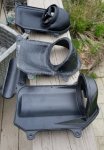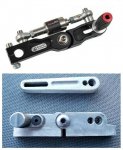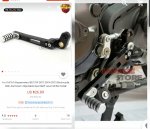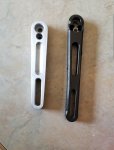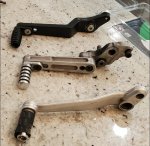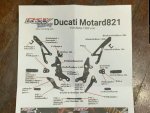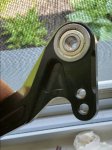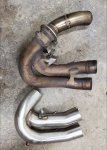Hello, it's time for me to share my build. It is a daily driver 2013 hypermotard 821. I have 24k miles on it and it gos up every day. I have it mostly where I want it but I want to share the high points of my build. A little about myself, I am a single income family with 4 kids and a wife. This requires me to be creative and thrifty in my build and modifications so I bought a lathe and milling machine a while back to aid in having fancy things. Most of the things I get are carefully selected second hand or new at a drastic discount(I kind of pride myself on finding the deal).
I'll start with the dry clutch conversion.
The clutch is a kbike slipper. The output shaft on the 821/939 is shorter than a normal dry clutch bike so the hub of the new clutch needed to be turned on the lathe to create a female recessed area that will accept the male shaped nut into the hub(every kit comes with the hub machined and a special sealing nut but noone will sell just the nut) That nut I'm using comes from the 1100 hyper as well as a few other bikes. One thing that messed me up 2 times now, in all the kits you see on line(there are 3 kits that are available) show a splined primary gear. The 821/939 has a tapered fit keyway retainer gear. This needed to be taken from the 916 or 1100 monster/hyper. The 1100 hyper EVO clutch gear is drilled to make it lighter. It drops the weight by a half of a pound. If you are doing this pay attention to the primary gear, the 821 and 939 are NOT splined.
The next big obstacle (or so i was thinking it would be). How to seal the clutch pushrod within the output shaft/clutch hub shaft. All the kits use a super fancy special nut that recesses into the hub and have a double seal built into the nut. I tried numerous times using various materials to make my own sealing nut buy failed every time. In the end I used that hyper 1100 male nut along with taking the new nut from the Kbike clutch, chocking it into the lathe and turning it into (essentially ) a fancy spacer. Next I needed to make a bushing that will support the push rod as well a sel the rod. I ended up using some oillite bushing stock and turning it down to fit inside of the output shaft yet house a seal (didn't get a pic of this . I'm sorry). Normally oil flows through this shaft to lubricate the wet clutch. The oil is stopped/slowed using a special oil block bolt that gos in place of a ball-on-spring design under the front sprocket on the left side of the engine. I am switching to dry so this needs to be blocked or else it will dump oil out the middle of the clutch)
One thing to note, I needed to go to the local bolt supplier to get new bolts for the dry clutch cover, the wet clutch cover bolts have a flair at the base that doesnt allow them to fit into the recesses in the cover. $8 for all allen head bolts with locking washers grade 8.
My bike came to me with 7k miles on it. Right now she is steadily climbing past 24k miles.
In the end this conversion slightly changed the ratio of the crank rotation to clutch speed due to being 1 tooth less for the primary gear on the dry set up. This made the bike feel quicker without sacrificing top speed much. The primary gear on the dry set up is slightly lighter. The whole dry clutch assembly along with the drilled clutch gear as a whole is heavier than the wet set up, 10.31lbs for the dry vs 9.32lbs for the wet(the added weight was after the primary gear. The primary gear itsself is lighter on the dry. I mention this because this primary gear Is directly on the crank,on the opposite side of the flywheel. This type of weight makes more of a difference in how the bike spins up and revs out vs anything after this gear). Since I was doing all this and had some down time I micro polished the gear faces just because.
While the engine was apart I decided to cut down the OEM steel flywheel. This also makes the bike more exciting in the way it makes power. It wants to rev out very quickly. It is very snappy. The down side is that you feel more of the fueling hiccups while maintaining any steady speed. But, to be honest the bike pulls VERY hard with everything connected to the crank being lighter and the fact that the clutch does not slip...at all once the lever is released.
There is alot more done. I will share as I get time.
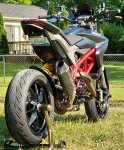
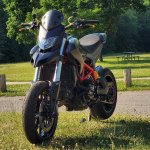
















I'll start with the dry clutch conversion.
The clutch is a kbike slipper. The output shaft on the 821/939 is shorter than a normal dry clutch bike so the hub of the new clutch needed to be turned on the lathe to create a female recessed area that will accept the male shaped nut into the hub(every kit comes with the hub machined and a special sealing nut but noone will sell just the nut) That nut I'm using comes from the 1100 hyper as well as a few other bikes. One thing that messed me up 2 times now, in all the kits you see on line(there are 3 kits that are available) show a splined primary gear. The 821/939 has a tapered fit keyway retainer gear. This needed to be taken from the 916 or 1100 monster/hyper. The 1100 hyper EVO clutch gear is drilled to make it lighter. It drops the weight by a half of a pound. If you are doing this pay attention to the primary gear, the 821 and 939 are NOT splined.
The next big obstacle (or so i was thinking it would be). How to seal the clutch pushrod within the output shaft/clutch hub shaft. All the kits use a super fancy special nut that recesses into the hub and have a double seal built into the nut. I tried numerous times using various materials to make my own sealing nut buy failed every time. In the end I used that hyper 1100 male nut along with taking the new nut from the Kbike clutch, chocking it into the lathe and turning it into (essentially ) a fancy spacer. Next I needed to make a bushing that will support the push rod as well a sel the rod. I ended up using some oillite bushing stock and turning it down to fit inside of the output shaft yet house a seal (didn't get a pic of this . I'm sorry). Normally oil flows through this shaft to lubricate the wet clutch. The oil is stopped/slowed using a special oil block bolt that gos in place of a ball-on-spring design under the front sprocket on the left side of the engine. I am switching to dry so this needs to be blocked or else it will dump oil out the middle of the clutch)
One thing to note, I needed to go to the local bolt supplier to get new bolts for the dry clutch cover, the wet clutch cover bolts have a flair at the base that doesnt allow them to fit into the recesses in the cover. $8 for all allen head bolts with locking washers grade 8.
My bike came to me with 7k miles on it. Right now she is steadily climbing past 24k miles.
In the end this conversion slightly changed the ratio of the crank rotation to clutch speed due to being 1 tooth less for the primary gear on the dry set up. This made the bike feel quicker without sacrificing top speed much. The primary gear on the dry set up is slightly lighter. The whole dry clutch assembly along with the drilled clutch gear as a whole is heavier than the wet set up, 10.31lbs for the dry vs 9.32lbs for the wet(the added weight was after the primary gear. The primary gear itsself is lighter on the dry. I mention this because this primary gear Is directly on the crank,on the opposite side of the flywheel. This type of weight makes more of a difference in how the bike spins up and revs out vs anything after this gear). Since I was doing all this and had some down time I micro polished the gear faces just because.
While the engine was apart I decided to cut down the OEM steel flywheel. This also makes the bike more exciting in the way it makes power. It wants to rev out very quickly. It is very snappy. The down side is that you feel more of the fueling hiccups while maintaining any steady speed. But, to be honest the bike pulls VERY hard with everything connected to the crank being lighter and the fact that the clutch does not slip...at all once the lever is released.
There is alot more done. I will share as I get time.



















Last edited by a moderator:























